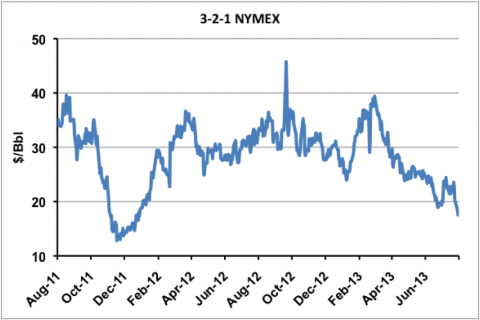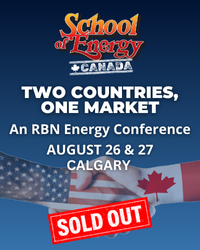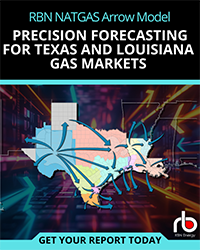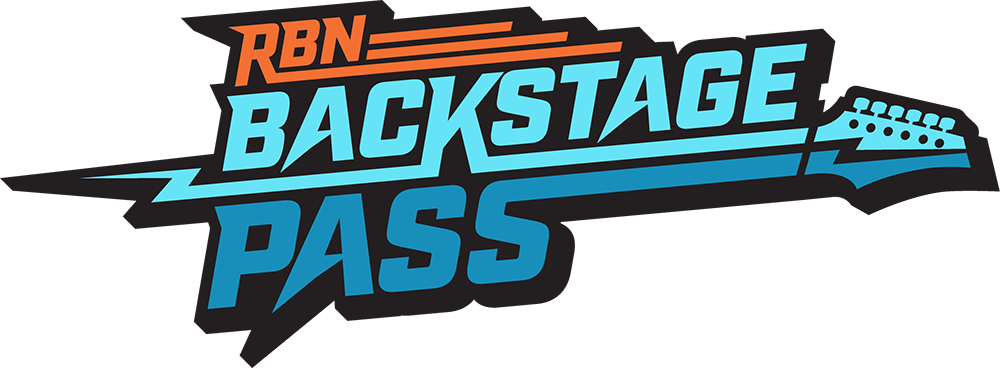Last week (August 7, 2013) the 3-2-1 crack spread based on NYMEX CME crude and refined product prices that is seen as a proxy for the performance of US refinery margins, reached a two year low. The 3-2-1 crack has fallen 56 percent this year from its high in March. At the same time refineries are still processing crude like there’s no tomorrow – at over 90 percent of capacity. Can the party continue? Today we peak through the cracks to uncover what’s going on.
What is a 3-2-1 Crack Spread?
To explain - the term “crack” does not refer to something a wayward crude trader might ingest in the bathroom but rather to breaking down or “cracking” crude oil. The term “spread” means the difference between the sales price of the refined products and the raw material cost of crude i.e. the refining margin. The 3-2-1 Crack spread approximates a refinery that produces two barrels of gasoline and one barrel of diesel for every three barrels of crude input. In other words the refinery yield is two-thirds gasoline, one-third diesel (see Bakken Buck Starts Here Part IV).
In our case the 3-2-1 crack we are looking at is the NYMEX CME futures market proxy for a refinery margin that is calculated using nearby delivery contract prices for New York Harbor gasoline and diesel (aka heating oil) and subtracting the cost of West Texas Intermediate (WTI) crude. This is the most widely followed crack spread because it roughly approximates the state of the US refining business. RBN Energy keeps a running tally on the 3-2-1 crack - you can see that chart and those of other important market indicators on our website. You get access to more detail behind the charts if you are an RBN member (see About Spot check Indicators).
Falling Through The Cracks
The chart below shows the 3-2-1 crack spread over the past two years. At the start of that period in August 2011, the WTI price was about a year into its three-year period of heavy discount to the international benchmark Brent crude (for chapter and verse on that saga see Strangers in the Night). Because inland crude prices like WTI were low, and the price of refined products in New York on the East Coast were based on higher international crude costs, the 3-2-1 crack in August 2011 was hovering around a very healthy $40/Bbl. Then the WTI discount to Brent narrowed sharply in the fall of 2011 as the market believed that the first phase of the Seaway pipeline reversal would miraculously solve the Midwest crude logjam quickly and that inland crude prices could return to coastal levels. That turned out not to be true once Seaway Phase 1 opened up in January 2012 and had little impact on the huge crude stockpile in Cushing, OK. The WTI discount to Brent widened out again in 2012 and 3-2-1 crack values bounced back over $30/Bbl. And they stayed at those levels until this year. The 3-2-1 crack peaked at $39.40 on March 8, 2013 and ever since then has been on a downward trend – reaching a low of $17.50/Bbl on August 7, 2013.
Source: CME data from Morningstar (Click to Enlarge)
Why has the 3-2-1 crack spread fallen by 56 percent since March 2013? The chart below shows the components of the spread in $/Bbl this year. The prices of diesel and gasoline (red and blue lines respectively on the chart), the refined products in the crack spread, basically tracked WTI crude prices (green line) through March. During March and April product prices were higher when output from Gulf Coast refineries that normally help meet demand on the East Coast was reduced by refinery maintenance (see Turn Around). That led to the near $40/Bbl 3-2-1 crack in early March. Ever since then the crack spread has tanked and the chief culprit was a rapid increase in WTI prices (brown dotted line on the chart). WTI prices increased by nearly $20/Bbl between April and June and product prices were flat over the same period. During this same period as WTI prices increased, refiners increased their crude throughput rapidly – chasing the higher margins
seen in March. By mid July the resulting increase in refined product output was putting downward pressure on prices (dark green dotted line on the chart) squeezing the crack spread further.
Source: CME data from Morningstar (Click to Enlarge)
The rising WTI prices that narrowed the 3-2-1 crack spread so dramatically reflected the unwinding of the WTI discount to Brent. The chart below on the right shows the WTI discount to Brent this year. That narrowing discount was caused by the opening up of new capacity to ship inland crude to coastal markets and reductions in the crude stockpile at Cushing. The WTI discount to Brent narrowed from over $23/Bbl in February to a few cents a barrel in late July before pushing out again to current levels around $3/Bbl. And as the WTI discount to Brent has evaporated, so have the margins that coastal refiners with access to inland crudes enjoyed. The chart below on the left shows both the 3-2-1 WTI NYMEX crack spread (blue line) and the 3-2-1 Brent crack (red line). An East Coast refiner with access to inland crudes priced against WTI (for example crude shipped by rail from the Bakken) would have been able to enjoy the high margin reflected by the WTI crack spread. East Coast refiners processing imported crudes like Brent would have fared less well. The desire to capture those higher margins from inland crudes has driven much of US crude distribution and refining activity over the past 18 months.
Join Backstage Pass to Read Full Article








